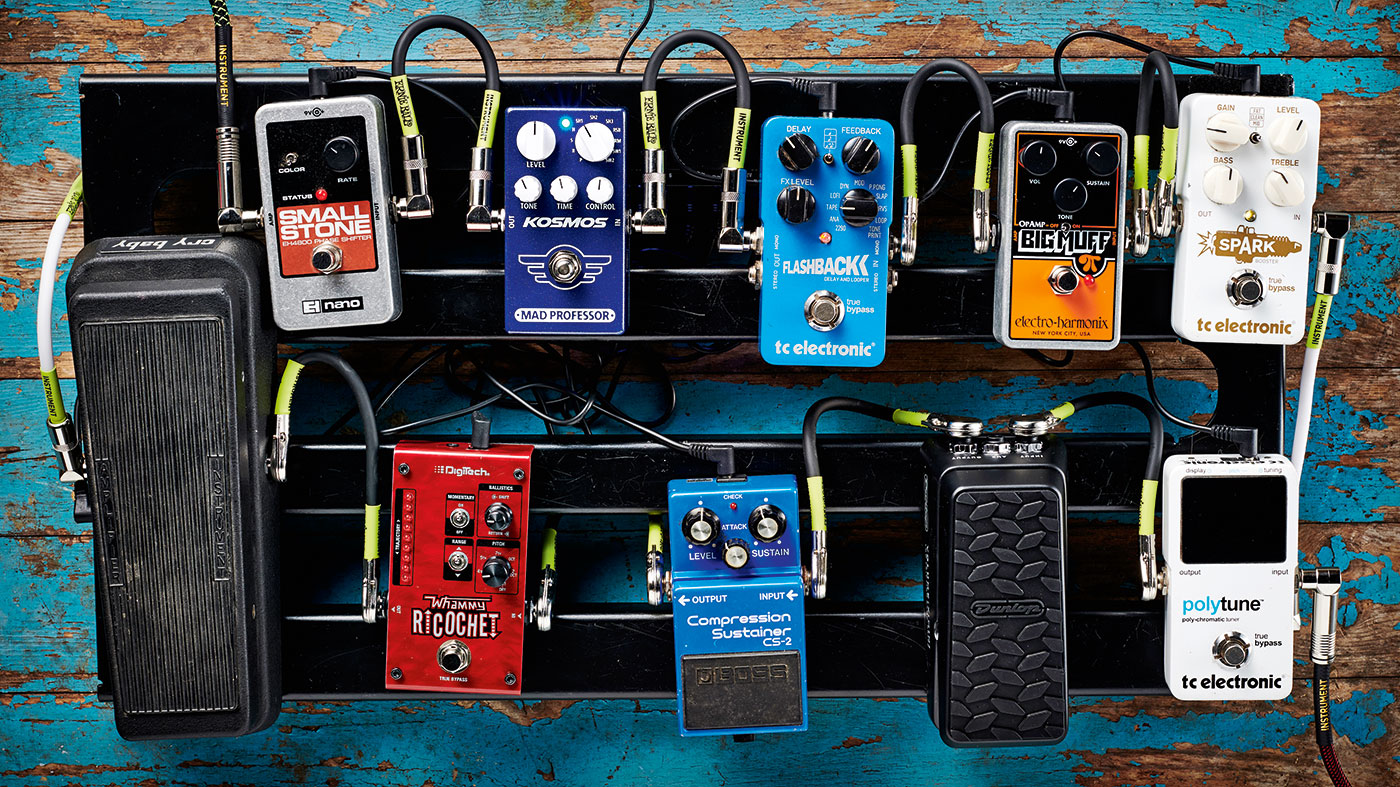Guitar pedal order: how to organise your pedalboard
Where to place those pedals

When it comes to putting a pedalboard together, there are a few golden rules it's worth making yourself aware of.
As ever, though, rules are made to be broken. Here, we present a nine-step guide pedal-positioning, plus some options for those looking to do it differently...
1. Volume
Where to put it: At the start of your chain. Placed here, it’s like having your guitar’s volume knob in pedal form.
Alternatively: If you don’t want trails from delays and reverbs, and want the signal’s decay, place it at the end. It can be quite dramatic to gradually roll off large, heavy guitar parts in a studio-like fade while playing live.
2. Compressor
Where to put it: Ideally, any compression should happen before the rest of the signal chain, so as to tame peaks, while still allowing for a jump in volume. Since compressors work by evening out the signal and adding gain, pedals after them, especially drives, might need their output level tweaking. Once they’re dialled in you’re set. Placed in front of drives, compressors can smooth their response while delivering a hotter signal to their input and a ‘fatter’ sound.
Alternatively: Put the compressor at the end of your chain. This will lessen the difference in amplitude between different potential signal paths within your board and result in a more consistent signal level. After all, when you record in a studio, there will almost certainly be compression put on your guitar post-amp and post-mic.
3. Whammy
Where to put it: After compression but before drives. Pitch shifters mangle your signal and compress it, so having drives after can clip and smooth some of the unpleasant artifacts and add additional complementary harmonics of their own.
Get the MusicRadar Newsletter
Want all the hottest music and gear news, reviews, deals, features and more, direct to your inbox? Sign up here.
Alternatively: Put it after delays so that you can dynamically use momentary effects to, say, mess with the trails of a decaying signal. A common math-rock trick is to put a pitch shifter after a Boss DD-3 with the time on minimum and the feedback on full for a momentary sci-fi sound effect.
4. Wah
Where to put it: Before drives for a full musical filter sound like Hendrix and Satriani. When placed before reverb and modulation, moving the wah slowly can result in an almost phaser-like filter that can be controlled dynamically with your foot for subtle, psychedelic motion under arpeggiated sections.
Alternatively: Place after fuzzes for a wild, extreme filter sound. Think Billy Corgan’s solo sounds on Smashing Pumpkins tracks like Slunk.
5. Preamp/Drive
Where to put it: Before drives and fuzzes. Smashing the input of drives makes a clipped, compressed, fatter tone.
Alternatively: After drives and fuzzes to function more like a lead boost. Here, it will still fatten the sound, but won’t increase the compression or clipping.
6. Fuzz/Distortion
Where to put it: Before delays and modulations, after drives and pitch shifters. Compressed or clipped signals can make the perceived volume of the guitar greater; given that delays and reverb work by creating copies of the signal, placing distortion after them can result in volume jumps or muddy tones. Placing them before makes the cut-off between repeats cleaner.
Alternatively: Put them before pitch shifters. As they’ll clip the guitar signal heavily, they’ll send a more compressed signal to the pitch shifter. This could be a radically different tone, depending on the fuzz and pitch shifter pedals used
7. Modulation
Where to put it: After your overdrives and distortions, so that all of the other effects in the chain are consistently filtered. The sound of something like a phaser or a flanger after drive can be powerful - think the solo from The Mooney Suzuki’s Alive And Amplified.
Alternatively: Try phaser or flanger before drive for a more subtle effect that gives a sense of movement to your playing - think Eddie Van Halen’s solo tone.
8. Delay
Where to put it: After drives; before reverb and modulation.
Alternatively: Put after reverb, or stack multiple delay and reverb pedals in series for huge ambient tones. The general rule of thumb tends to be: for clarity, stack from a moderately long delay time, and get longer as you move down the chain. For ambient players, start with a shorter initial time and get longer from the second delay on.
9. Reverb
Where to put it: After delays, so that your delay is still clear. The combination of delay and reverb can be great for ambient noodling, but using them in such a way that they don’t become an indistinct wash can be tricky.
With reverb placed after delay, rolling off the treble on a reverb is sufficient to get a huge pad sound, or an ambient tone for clean, atmospheric sections, without the reverb becoming overpowering.
Alternatively: Put your reverb in front of your drives, or run it into a dirty amp. This dark tone can be brooding. It’s a great trick to try in the studio if you’re experimenting with alternative signal orders, and is allegedly the preferred pedal order of Steven Wilson from Porcupine Tree, who runs his delays and reverb into the dirt channel of his amp.
Total Guitar is Europe's best-selling guitar magazine.
Every month we feature interviews with the biggest names and hottest new acts in guitar land, plus Guest Lessons from the stars.
Finally, our Rocked & Rated section is the place to go for reviews, round-ups and help setting up your guitars and gear.
Subscribe: http://bit.ly/totalguitar
"The Rehearsal is compact, does its one job well, and is easy to navigate without needing instructions": Walrus Audio Canvas Rehearsal review
“The EP635 delivers the unmistakable high-gain aggression and clarity that Engl fans love”: Engl packs its iconic Fireball head into a compact dual-channel stompbox with onboard noise gate and IR support










